engine lexus LFA 2012 Technical Information / LEXUS 2012 LFA: INSIDE THE LFA
[x] Cancel search | Manufacturer: LEXUS, Model Year: 2012, Model line: LFA, Model: Lexus LFA 2012Pages: 128, PDF Size: 5.91 MB
Page 4 of 128

2
Contents
Section 01
Basic operations P.8
Engine protection mechanisms P.16
Ideal driving position P.20
Operating the driving mode selector switch P.2 6
Accelerating P.32
Shifting P.36
Steering P.44
Braking P.50
Checking the engine P.56
Using the meter P.66
Page 7 of 128
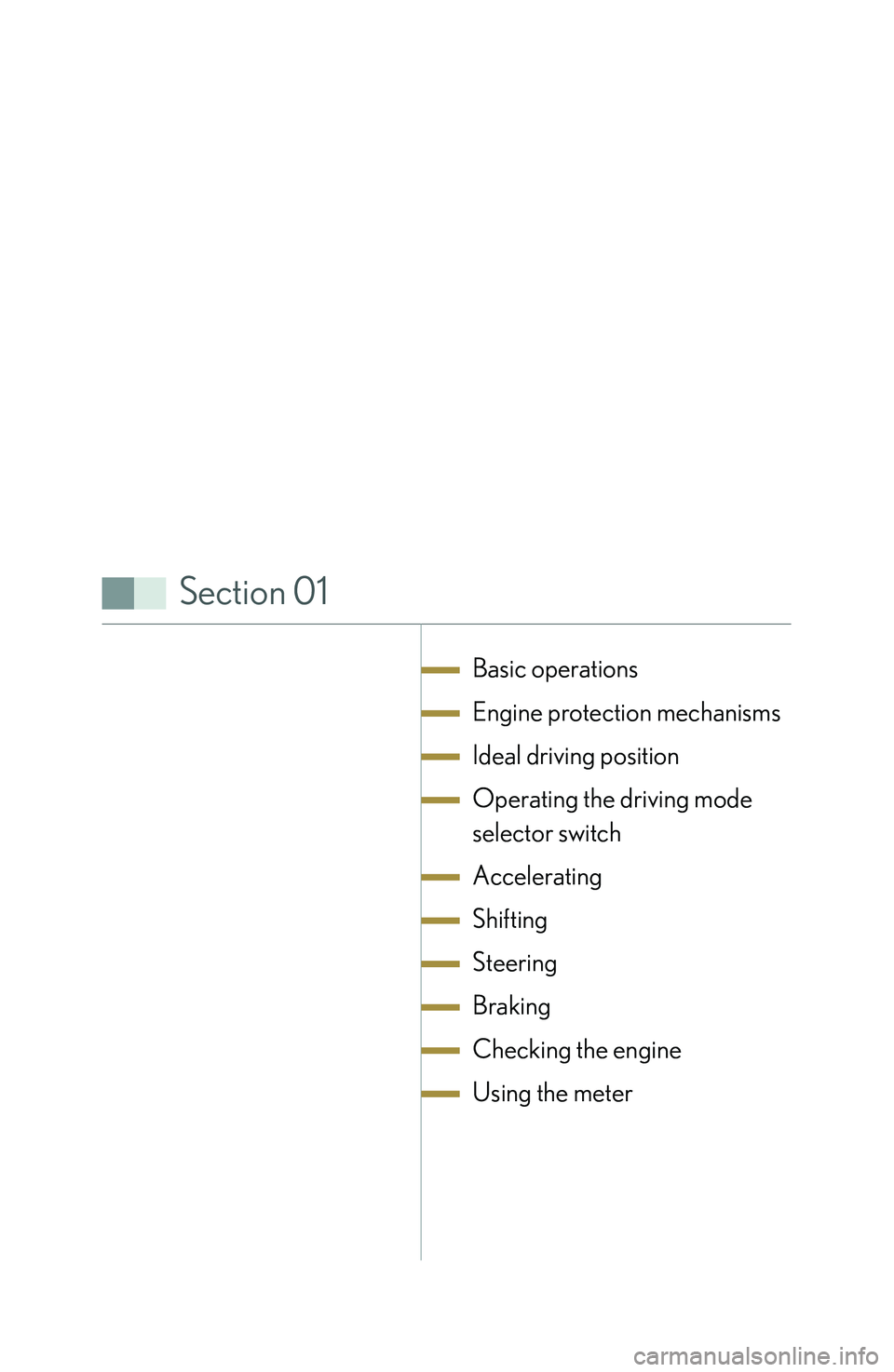
Section 01
Basic operations
Engine protection mechanisms
Ideal driving position
Operating the driving mode
selector switch
Accelerating
Shifting
Steering
Braking
Checking the engine
Using the meter
Page 11 of 128
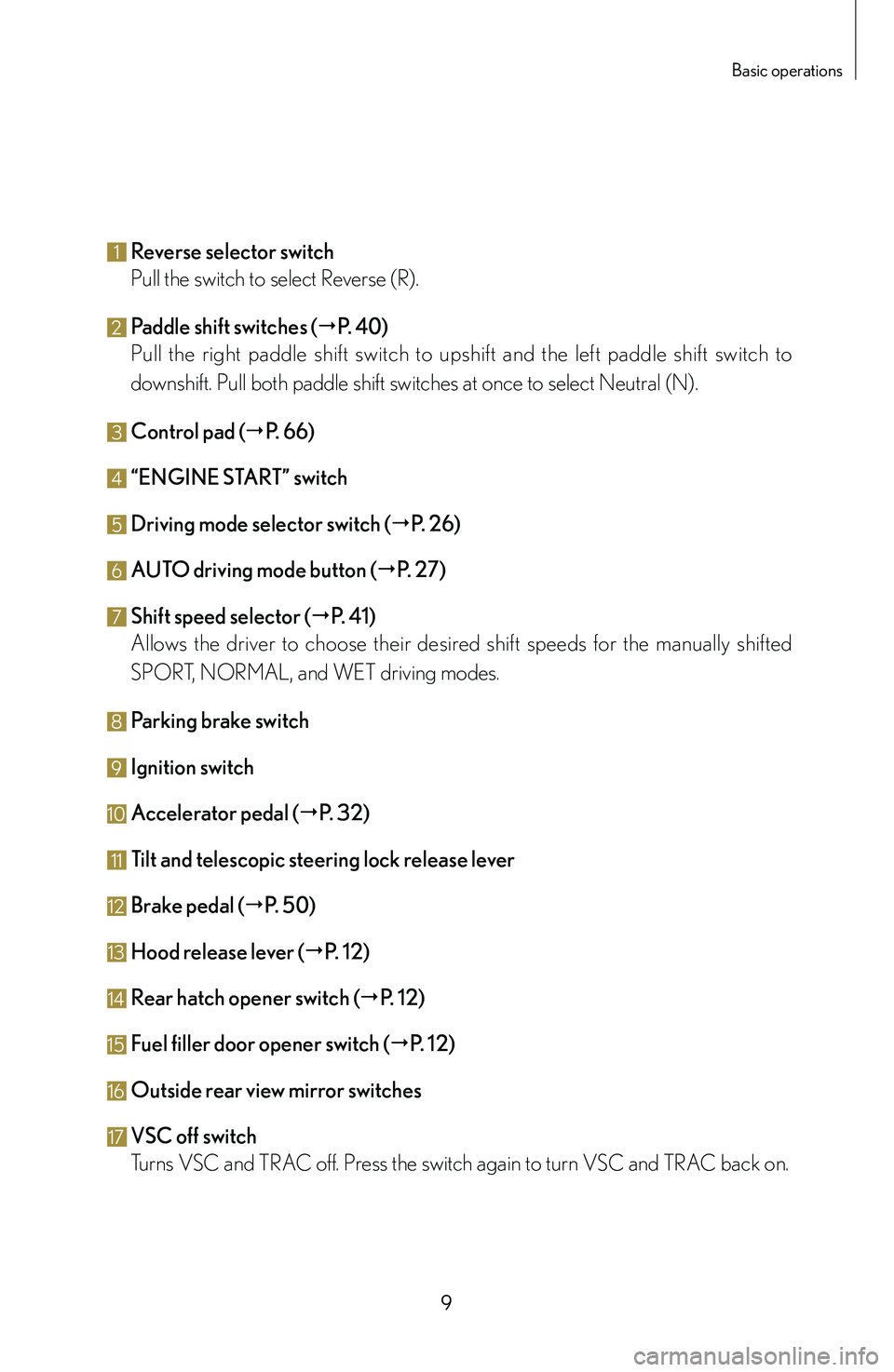
9
Basic operations
1 Reverse selector switch
Pull the switch to select Reverse (R).
2 Paddle shift switches ("P. 40)
Pull the right paddle shift switch to upshift and the left paddle shift switch to
downshift. Pull both paddle shift switches at once to select Neutral (N).
3 Control pad ("P. 66)
4 “ENGINE START” switch
5 Driving mode selector switch ("P. 26)
6 AUTO driving mode button ("P. 27)
7 Shift speed selector ("P. 41)
Allows the driver to choose their desired shift speeds for the manually shifted
SPORT, NORMAL, and WET driving modes.
8 Parking brake switch
9 Ignition switch
10 Accelerator pedal ("P. 32)
11 Tilt and telescopic steering lock release lever
12 Brake pedal ("P. 50)
13 Hood release lever ("P. 12)
14 Rear hatch opener switch ("P. 12)
15 Fuel filler door opener switch ("P. 12)
16 Outside rear view mirror switches
17 VSC off switch
Turns VSC and TRAC off. Press the switch again to turn VSC and TRAC back on.
Page 12 of 128
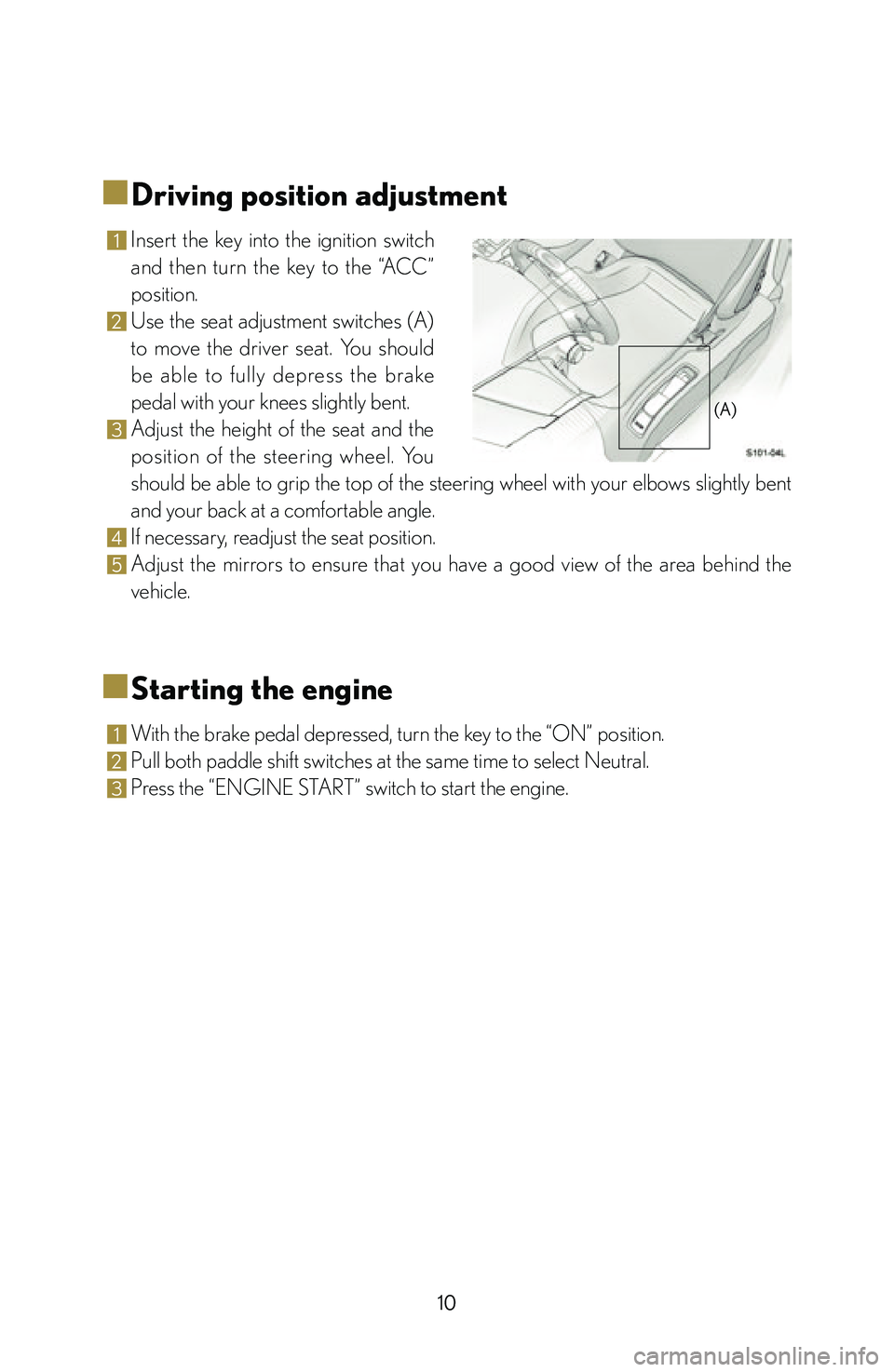
10
■
■Driving position adjustment
1 Insert the key into the ignition switch
and then turn the key to the “ACC”
position.
2 Use the seat adjustment switches (A)
to move the driver seat. You should
be able to fully depress the brake
pedal with your knees slightly bent.
3 Adjust the height of the seat and the
position of the steering wheel. You
should be able to grip the top of the steering wheel with your elbows slightly bent
and your back at a comfortable angle.
4 If necessary, readjust the seat position.
5 Adjust the mirrors to ensure that you have a good view of the area behind the
vehicle.
■
■Starting the engine
1 With the brake pedal depressed, turn the key to the “ON” position.
2 Pull both paddle shift switches at the same time to select Neutral.
3 Press the “ENGINE START” switch to start the engine.
(A)
Page 13 of 128

11
Basic operations
■
■Starting off
1 With the brake pedal depressed, pull the right paddle shift switch to select 1st gear.
2 Pull the parking brake switch to release the parking brake.
3 Release the brake pedal and then slowly depress the accelerator pedal.
■
■Reversing
1 With the vehicle stationary, depress the brake pedal and check the gear indicator
in the meter to ensure that Neutral is selected.
2 Pull the reverse selector switch to select Reverse.
3 Release the brake pedal and then slowly depress the accelerator pedal.
It is not possible to change directly from Reverse to any of the forward gears. Select Neutral first
and then select a forward gear.
■
■Parking
1 Depress the brake pedal until the vehicle comes to a complete stop.
2 Press the parking brake switch to set the parking brake.
3 Ensure that “D1”, “1” or “R” is displayed on the gear indicator.
4 Push in the key and turn it to the “LOCK” position to stop the engine.
The “ENGINE START” switch is for starting the engine. It cannot be used to stop the engine.
Page 15 of 128
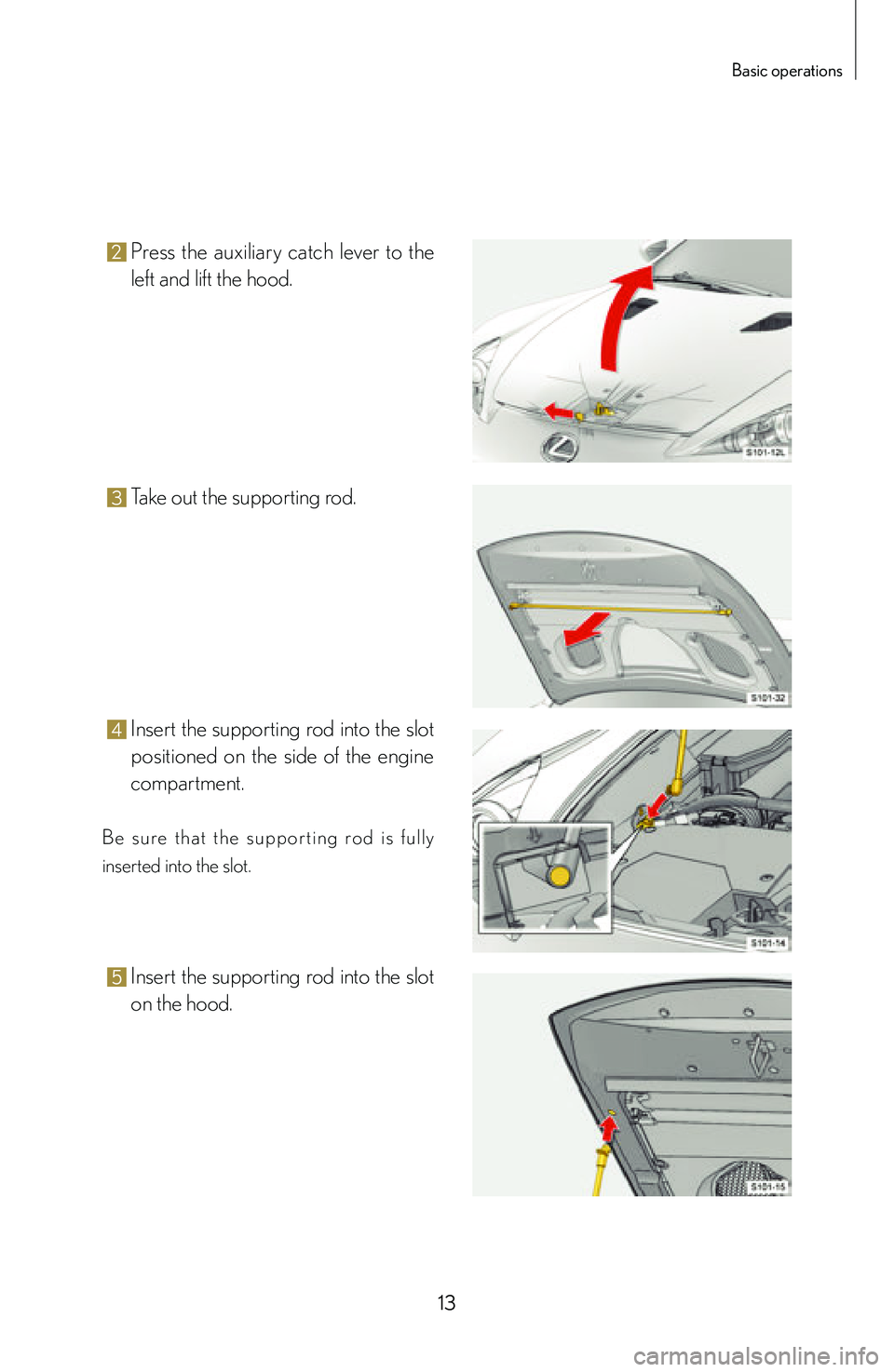
13
Basic operations
2 Press the auxiliary catch lever to the
left and lift the hood.
3 Take out the supporting rod.
4 Insert the supporting rod into the slot
positioned on the side of the engine
compartment.
B e s u re t h a t t h e s u p p o r t i n g ro d i s f u l l y
inserted into the slot.
5 Insert the supporting rod into the slot
on the hood.
Page 18 of 128
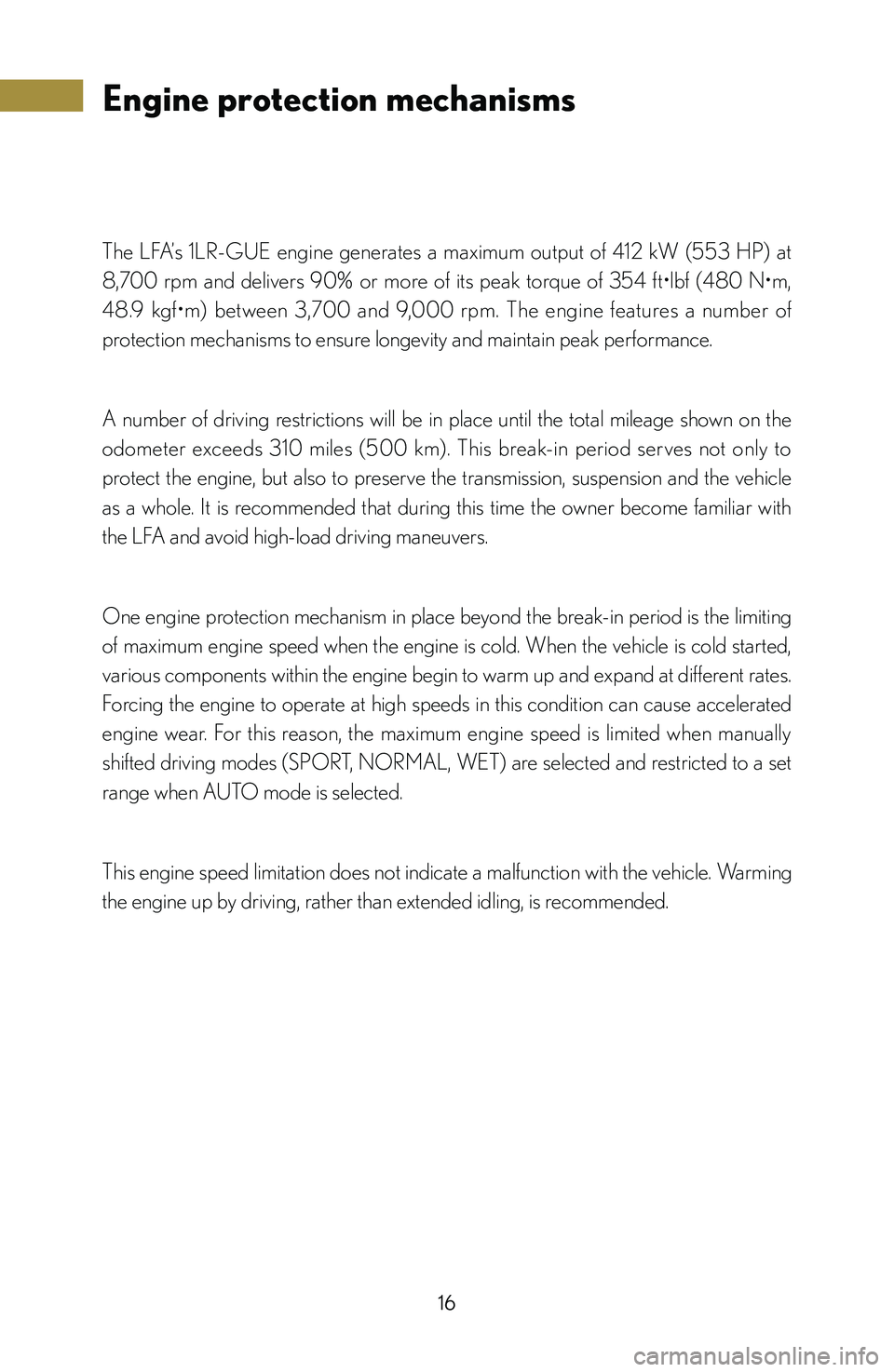
16
Engine protection mechanisms
The LFA’s 1LR-GUE engine generates a maximum output of 412 kW (553 HP) at
8,700 rpm and delivers 90% or more of its peak torque of 354 ft•lbf (480 N•m,
48.9 kgf•m) between 3,700 and 9,000 rpm. The engine features a number of
protection mechanisms to ensure longevity and maintain peak performance.
A number of driving restrictions will be in place until the total mileage shown on the
odometer exceeds 310 miles (500 km). This break-in period serves not only to
protect the engine, but also to preserve the transmission, suspension and the vehicle
as a whole. It is recommended that during this time the owner become familiar with
the LFA and avoid high-load driving maneuvers.
One engine protection mechanism in place beyond the break-in period is the limiting
of maximum engine speed when the engine is cold. When the vehicle is cold started,
various components within the engine begin to warm up and expand at different rates.
Forcing the engine to operate at high speeds in this condition can cause accelerated
engine wear. For this reason, the maximum engine speed is limited when manually
shifted driving modes (SPORT, NORMAL, WET) are selected and restricted to a set
range when AUTO mode is selected.
This engine speed limitation does not indicate a malfunction with the vehicle. Warming
the engine up by driving, rather than extended idling, is recommended.
Page 19 of 128
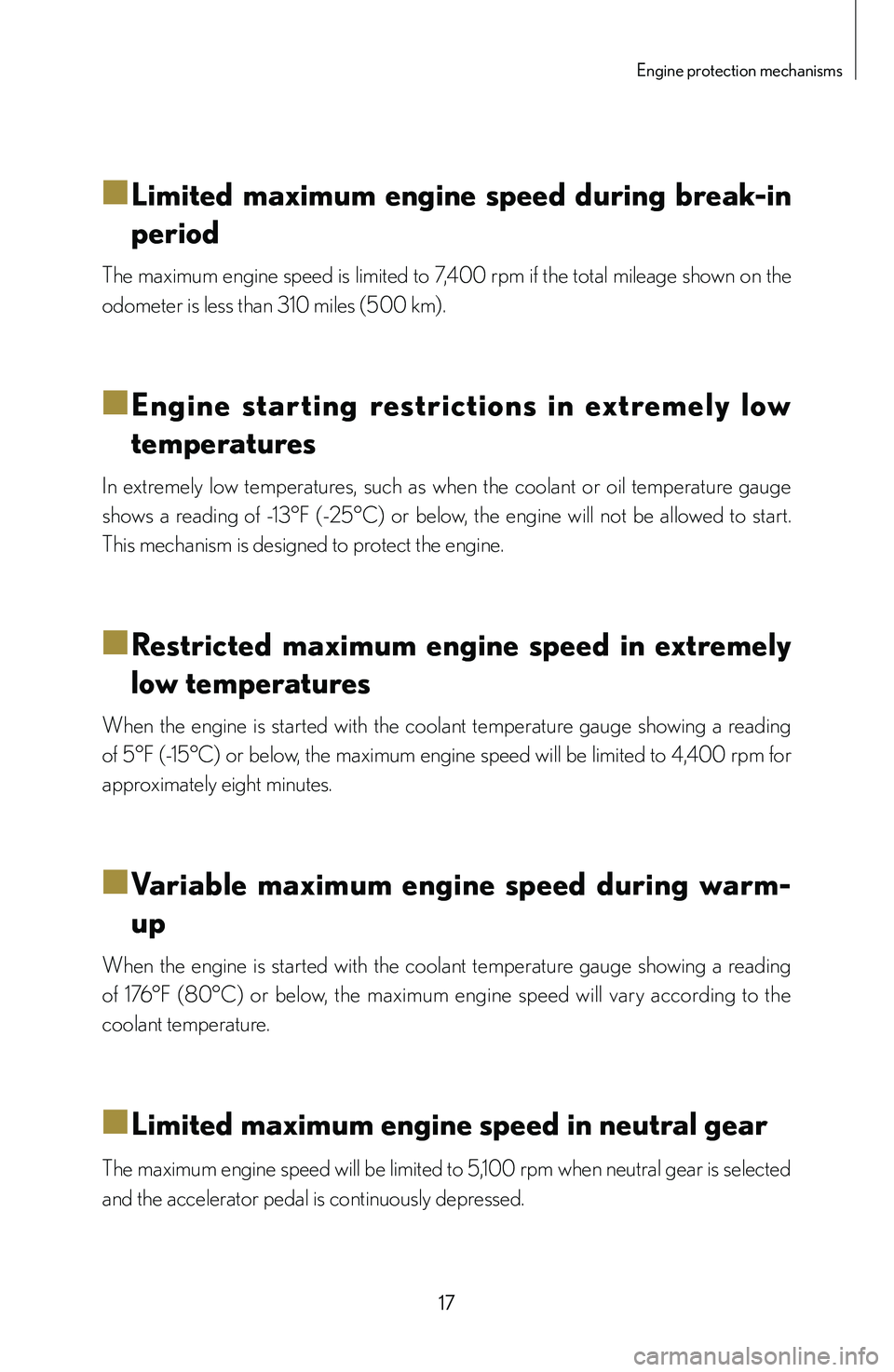
17
Engine protection mechanisms
■
■Limited maximum engine speed during break-in
period
The maximum engine speed is limited to 7,400 rpm if the total mileage shown on the
odometer is less than 310 miles (500 km).
■
■Engine starting restrictions in extremely low
temperatures
In extremely low temperatures, such as when the coolant or oil temperature gauge
shows a reading of -13°F (-25°C) or below, the engine will not be allowed to start.
This mechanism is designed to protect the engine.
■
■Restricted maximum engine speed in extremely
low temperatures
When the engine is started with the coolant temperature gauge showing a reading
of 5°F (-15°C) or below, the maximum engine speed will be limited to 4,400 rpm for
approximately eight minutes.
■
■Variable maximum engine speed during warm-
up
When the engine is started with the coolant temperature gauge showing a reading
of 176°F (80°C) or below, the maximum engine speed will vary according to the
coolant temperature.
■
■Limited maximum engine speed in neutral gear
The maximum engine speed will be limited to 5,100 rpm when neutral gear is selected
and the accelerator pedal is continuously depressed.
Page 34 of 128
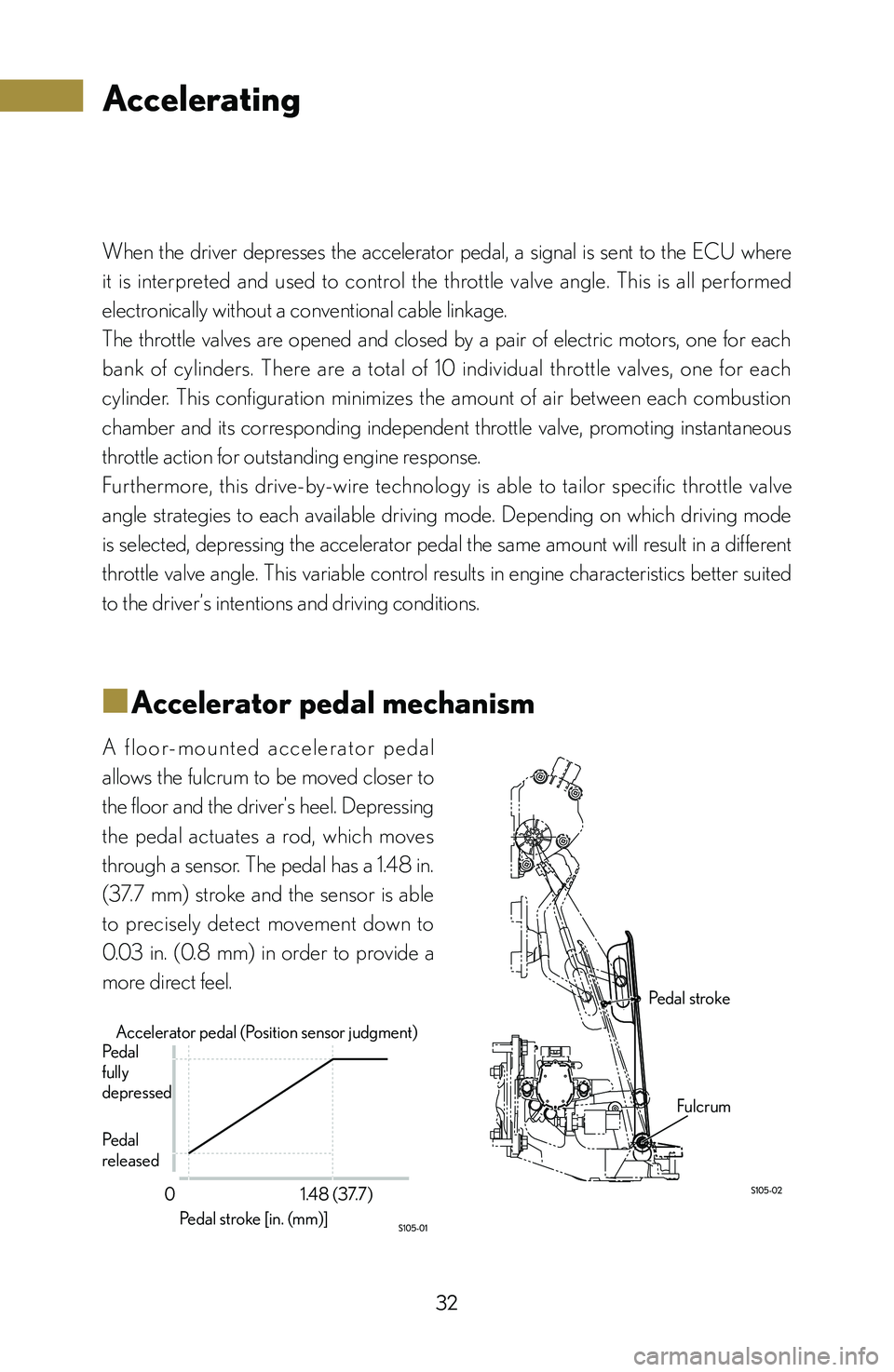
32
When the driver depresses the accelerator pedal, a signal is sent to the ECU where
it is interpreted and used to control the throttle valve angle. This is all performed
electronically without a conventional cable linkage.
The throttle valves are opened and closed by a pair of electric motors, one for each
bank of cylinders. There are a total of 10 individual throttle valves, one for each
cylinder. This configuration minimizes the amount of air between each combustion
chamber and its corresponding independent throttle valve, promoting instantaneous
throttle action for outstanding engine response.
Furthermore, this drive-by-wire technology is able to tailor specific throttle valve
angle strategies to each available driving mode. Depending on which driving mode
is selected, depressing the accelerator pedal the same amount will result in a different
throttle valve angle. This variable control results in engine characteristics better suited
to the driver’s intentions and driving conditions.
■
■Accelerator pedal mechanism
A f l o o r- m o u n t e d a c c e l e r a t o r p e d a l
allows the fulcrum to be moved closer to
the floor and the driver's heel. Depressing
the pedal actuates a rod, which moves
through a sensor. The pedal has a 1.48 in.
(37.7 mm) stroke and the sensor is able
to precisely detect movement down to
0.03 in. (0.8 mm) in order to provide a
more direct feel.
Pedal stroke
Fulcrum
Accelerator pedal (Position sensor judgment)
Pedal
released Pedal
fully
depressed 0 1.48 (37.7)
Pedal stroke [in. (mm)]
Accelerating
Page 35 of 128
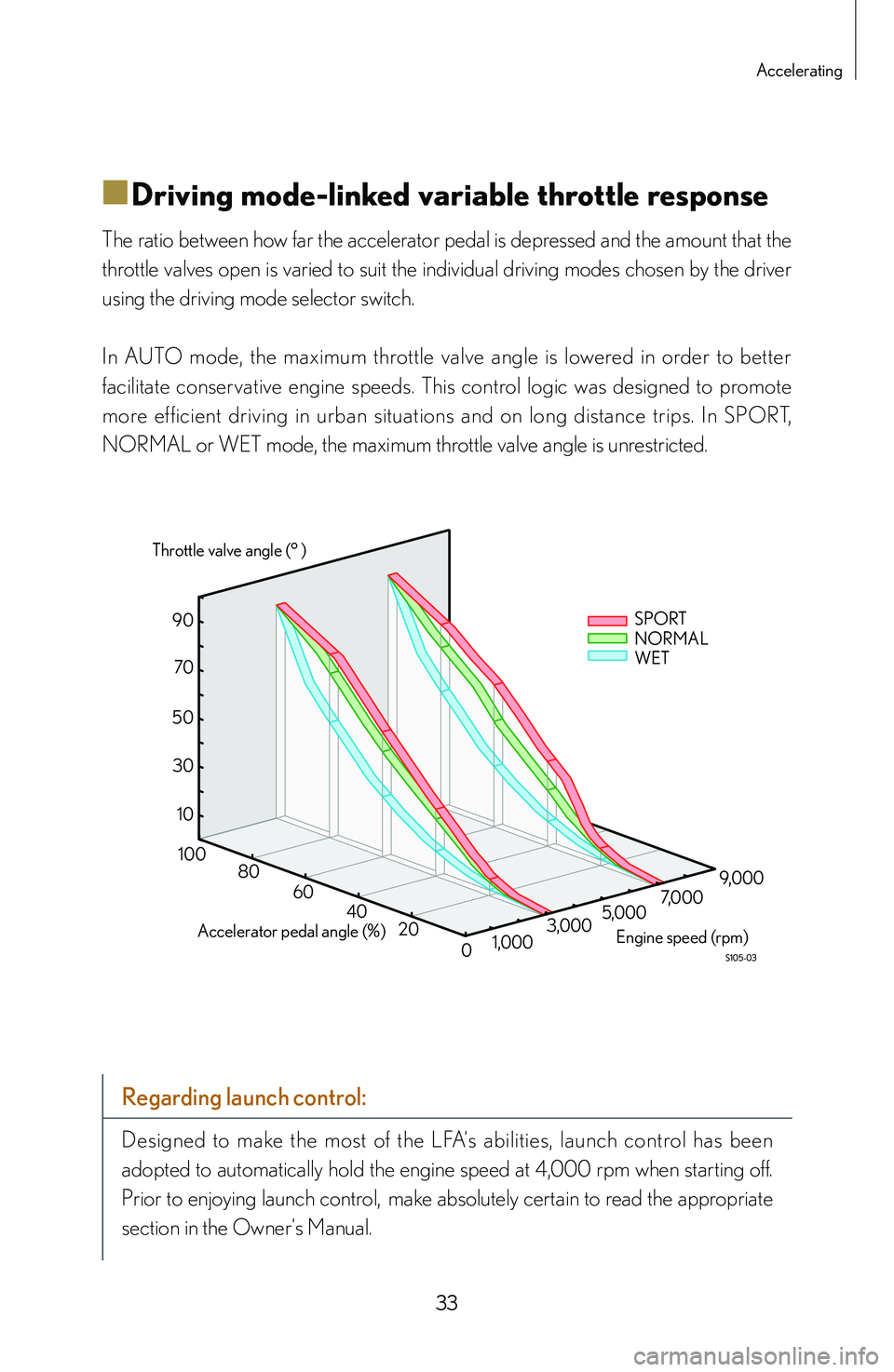
33
Accelerating
■
■Driving mode-linked variable throttle response
The ratio between how far the accelerator pedal is depressed and the amount that the
throttle valves open is varied to suit the individual driving modes chosen by the driver
using the driving mode selector switch.
In AUTO mode, the maximum throttle valve angle is lowered in order to better
facilitate conservative engine speeds. This control logic was designed to promote
more efficient driving in urban situations and on long distance trips. In SPORT,
NORMAL or WET mode, the maximum throttle valve angle is unrestricted.
SPORT
Engine speed (rpm)
Accelerator pedal angle (%)
Throttle valve angle (° )
WET NORMAL
90
70
50 30 10100 80
604020
01,000 3,000
5,000 7,0009,000
Regarding launch control:
Designed to make the most of the LFA’s abilities, launch control has been
adopted to automatically hold the engine speed at 4,000 rpm when starting off.
Prior to enjoying launch control,
make absolutely certain to read the appropriate
section in the Owner’s Manual.